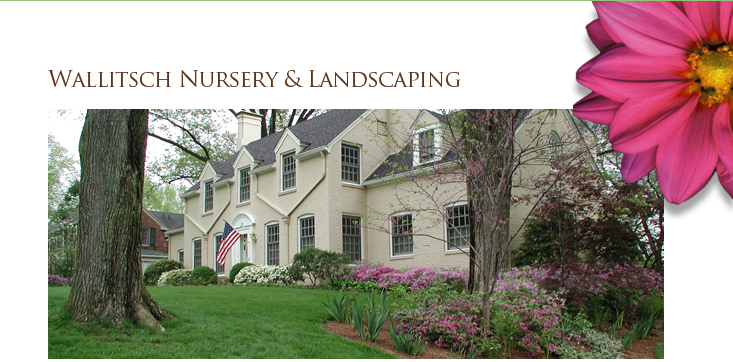Caring for your new landscape development is critical for it’s longevity and ability to become a self-sustaining part of your home or business. Listed below are a few suggestions to help you maintain the landscape development and enjoy the beauty it will provide for you with just a little care.
Watering
Mulching
Spraying
Fertilizing
Weed Infestations
Pruning
Watering
The first year is the most critical for your new landscape. It is during this time that proper watering is most important to the establishment of newly planted trees and shrubs. It is essential that the following instructions be completed so plants can become well established. This is best accomplished by deep watering. Place the end of the hose at the base of each plant next to the main trunk and allow water to trickle slowly on the root ball. Water each small 1 or 2 gallon plant for 4 or 5 minutes - 30-60 minutes for larger trees or shrubs. Remember, you must apply water to the root ball of the shrub. Any water falling to the outside of the root ball will not be absorbed by the root system of the plant during the first year. Watering should be done approximately once a week from May through October regardless of rainfall. During hot, dry weather, it may be necessary to water 2 times a week.
After one year, when the shrubs’ roots have spread beyond the original root ball, they can be watered with perforated soaker hoses placed at the base of the plants. This is a very effective method of deep watering, and is less time-consuming. Lay the soaker hose in place around one or more plants and turn on the faucet just enough to get a slow trickle of water flowing that will seep down into the soil around the plants. This should require approximately 20 to 30 minutes a week.
Drought stressed plants become targets for insects and diseases. Therefore, regardless of the age of your plants, they will always benefit from regular watering during dry periods.
Mulching
If mulching was included in the landscape installation, no additional mulch should be required for 12 months. At that time, it may be necessary to add some mulch to thin spots. This is important to all plants since mulching reduces evaporation, lowers soil temperature, and helps prevent weed growth. If your landscape job did not include mulch, we recommend that 2 to 3 inches of bark mulch be applied in early spring. It will save lots of weeding time and help during dry spells. Mulch comes in 3 cubic foot bags or in bulk. We also have Pine Needle Bales available.
Spraying
Your plants are insect and disease free when planted. Red Spider, Lacewing Fly, and Aphids are common insect pests on shrubs and trees in our area, and can be easily controlled by insecticides or miticides applied in April, May, and if necessary, June. Japanese Beetles and Bagworms, which can be controlled with applications of Sevin, may appear during June or July. Another pest, Scale, can be controlled by a dormant oil spray applied either in early November or March. Mildew or Fungus sprays can be applied any time these conditions are evident.
All of these products can be applied with a hose attachment sprayer or a pressure sprayer. Always read the label before spraying. Again, when in doubt, just give us a call and we will try to diagnose the problem and advise you. There is also helpful information available through the Kentucky Office of the State Entomologist website: www.kystateent.org
Fertilizing
All plants and beds have been fertilized with a balanced plant food at the time of planting and do not have to be fed for 6 months or until the following spring, whichever occurs first. Spread fertilizer around the dripline of trees or shrubs like you would spread grass seed. Do not apply fertilizer in large clumps or piles on the root ball or over the foliage. High concentration of fertilizer can cause fertilizer burn. If this occurs, spread clumps with a broom rake or brush off foliage with a broom.
Weed infestations
Weed seeds lie dormant in the soil and are activated when the soil is disturbed. This is why frequently after flower and shrub beds are made, weeds come up in profusion. We didn’t bring them into your garden. A granular pre-emergent, such as Preen of Garden Weed Preventer, can be applied to your shrub beds in early spring to prevent the germination of some weeds. Weeds that come up after the pre-emergent herbicide has been applied will have to be controlled by a post-emergent herbicide or by hand pulling. We recommend Roundup to control emerged weeds. Roundup can be safely used around trees and shrubs, but do not let spray drift onto desirable trees and shrubs. It may cause leaf burn or could kill some plants. Always read the label before applying any herbicide.
Pruning
Spring flowering shrubs such as azalea, rhododendron, forsythia, lilac, etc. should be trimmed between May and mid July. Do not trim these shrubs after August because you will be removing next spring’s bloom buds. Summer flowering shrubs such as hydrangea, crape myrtle, butterfly bush, etc. can be trimmed anytime between the end of November to the middle of March. Evergreens such as holly, boxwood, taxus and juniper can be trimmed anytime during the year depending on whether you want a formal or informal look.
